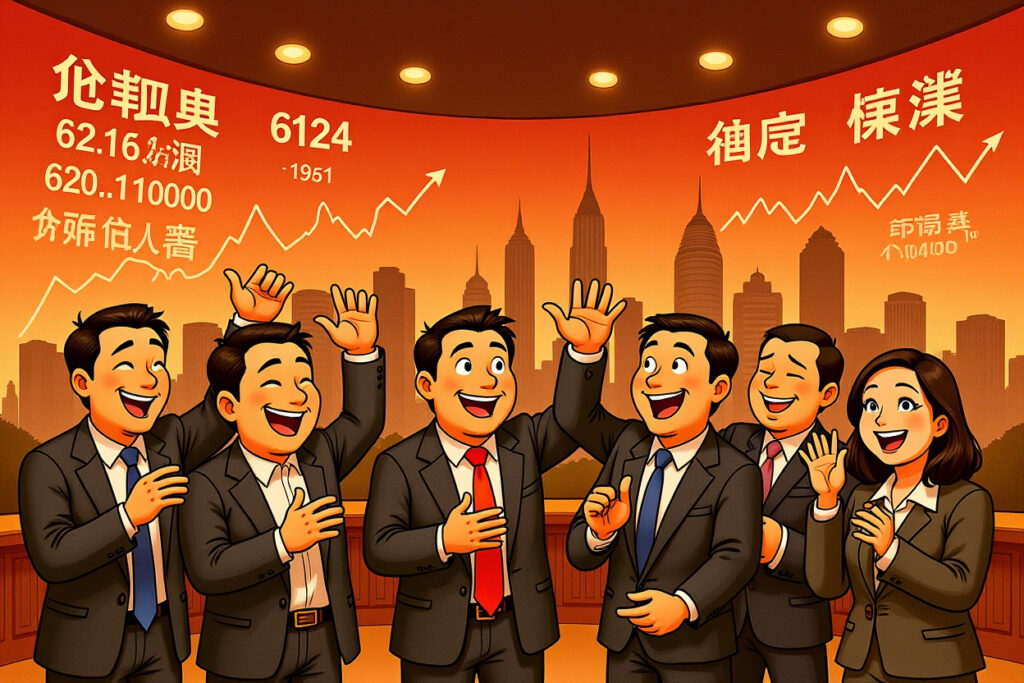Market Expert Challenges IPO Expansion Calls Amid Recovery
As Chinese equity markets show signs of stabilization following recent volatility, a contentious debate has emerged regarding the appropriate pace of initial public offerings. Dong Shaopeng (董少鹏), senior researcher at Renmin University’s Chongyang Institute for Financial Studies, has delivered a forceful critique against proponents advocating accelerated IPO processes primarily to facilitate venture capital exits. His remarks, made ahead of the 2025 Phoenix Bay Area Financial Forum, highlight fundamental tensions between short-term profit motives and long-term market development priorities.
The discussion arrives at a critical juncture for China’s capital markets, which have experienced significant regulatory reforms and valuation adjustments throughout 2025. With investor confidence gradually returning, market participants are divided on whether this recovery should trigger increased listing activity or whether authorities should maintain a more measured approach to new issuances.
Contextualizing the Current IPO Environment
China’s securities regulators have implemented numerous market-stabilizing measures throughout the past eighteen months, including adjusted listing requirements, enhanced disclosure standards, and modified trading mechanisms. These changes have created a more selective environment for public listings, with approval rates declining from previous peaks. According to China Securities Regulatory Commission (CSRC 中国证监会) data, IPO volume decreased approximately 28% year-over-year through the first half of 2025, while average offering sizes increased by 15%.
This shift toward quality-over-quantity reflects regulatory priorities that align with Dong’s perspective. The market’s core functions of price discovery, capital allocation, and corporate governance have received increased emphasis following several high-profile corporate failures and accounting scandals that eroded investor trust in previous years.
The Fundamental Purpose of Public Listings
Dong’s central argument challenges the increasingly prevalent notion that capital markets primarily serve as exit mechanisms for early investors. This perspective represents a significant departure from certain Western market philosophies that often prioritize liquidity events for venture capital and private equity firms. Instead, Dong emphasizes that China’s market development strategy should focus on creating sustainable value through rigorous pricing mechanisms, corporate restructuring opportunities, and enhanced supervisory frameworks.
The market’s core functions extend far beyond simply providing liquidity to pre-IPO investors. Effective markets facilitate optimal capital allocation by directing resources toward the most promising enterprises while simultaneously disciplining underperformers through price mechanisms and potential takeover activity. This creates a virtuous cycle where successful companies access expansion capital while struggling entities face pressure to improve operations or exit the public marketplace.
Pricing Mechanism as Primary Market Function
Price discovery represents perhaps the most critical function of any developed capital market. Through the collective wisdom of diverse market participants engaging in voluntary transactions, securities prices theoretically reflect all available information about a company’s prospects. This pricing mechanism allows capital to flow toward enterprises demonstrating strong fundamentals and growth potential while withholding funding from less promising ventures.
When IPO processes become disconnected from fundamental valuation principles and instead serve primarily as exit opportunities for early investors, this price discovery function becomes distorted. Companies may achieve inflated valuations during offering processes that don’t reflect their true prospects, ultimately leading to investor losses when market prices eventually correct toward fundamental values.
Quality Over Quantity: Rethinking Listing Standards
The debate over appropriate IPO volume intersects with broader discussions regarding listing standards and continuing obligations for public companies. Dong’s comments implicitly endorse the regulatory trend toward heightened listing requirements that emphasize sustainable business models, transparent governance structures, and long-term competitive advantages rather than merely growth metrics or innovation narratives.
China’s registration-based IPO system, fully implemented across all exchanges in 2024, theoretically allows market forces to play a greater role in determining which companies achieve public listing. However, regulators retain significant oversight authority to prevent market overheating and protect less sophisticated investors from potentially speculative offerings. This balanced approach acknowledges both market mechanisms and regulatory responsibilities.
The Delisting Imperative for Underperformers
An efficient capital market requires robust entry and exit mechanisms. While much attention focuses on IPO access, Dong appropriately highlights the equally important process of removing companies that fail to meet continuing listing standards. A market that readily admits new listings but struggles to delist underperformers inevitably becomes bloated with substandard investment options, reducing overall market efficiency and investor returns.
China has made significant progress in strengthening delisting mechanisms in recent years, with the number of companies removed from exchanges increasing substantially since 2020. According to exchange statistics, delistings reached record levels in 2024, with 47 companies removed from the Shanghai Stock Exchange (上海证券交易所) and Shenzhen Stock Exchange (深圳证券交易所) combined. This trend reflects regulatory commitment to market quality rather than simply market size.
Venture Capital Ecosystem Considerations
The venture capital industry plays a crucial role in funding innovation and supporting early-stage companies through their development phases. However, the relationship between venture funding and public markets requires careful balance. While VC firms appropriately seek returns on successful investments, public markets should not primarily function as automated exit vehicles without regard for company readiness or market conditions.
China’s venture capital industry has matured significantly over the past decade, with total assets under management exceeding ¥4 trillion RMB according to Asset Management Association of China (中国证券投资基金业协会) data. This growing institutional framework creates both opportunities and responsibilities regarding how venture-backed companies transition to public markets.
Alternative Exit Mechanisms Beyond IPOs
An overemphasis on IPOs as the preferred exit mechanism overlooks numerous alternative pathways for venture investors to realize returns. Secondary transactions, strategic acquisitions, and special purpose acquisition companies (SPACs) all represent potential alternatives that might better align with specific company circumstances and market conditions.
The development of China’s mergers and acquisitions market has created increasingly viable alternatives to traditional IPOs. According to PwC China data, M&A transaction value involving venture-backed companies increased 32% year-over-year in 2024, suggesting growing acceptance of acquisition-based exits rather than public offerings.
Regulatory Perspective and Market Development
China’s securities regulators face the complex challenge of balancing multiple objectives: facilitating capital formation for promising companies, protecting investors from fraudulent or speculative offerings, maintaining market stability, and supporting national economic priorities. These sometimes competing goals require nuanced approaches that evolve with market conditions and development stages.
The China Securities Regulatory Commission (CSRC 中国证监会) has consistently emphasized market quality over quantity in recent public communications. Chairman Wu Qing (吴清) has repeatedly highlighted the importance of investor protection and market stability, suggesting regulatory alignment with Dong’s perspective regarding appropriate IPO pacing and standards.
International Comparative Analysis
Global capital markets demonstrate various approaches to balancing IPO volume with market quality considerations. The United States experienced similar debates following the dot-com bubble and again after several high-profile technology company disappointments in recent years. These experiences highlight the risks of allowing exit motivations to overwhelm fundamental analysis in public offering processes.
European markets, particularly the London Stock Exchange, have implemented numerous reforms aimed at enhancing post-IPO performance through improved listing standards and continuing obligations. These international examples provide valuable reference points for Chinese regulators considering appropriate market structure reforms.
Strategic Implications for Market Participants
Investors, companies, and financial intermediaries must all adapt to the evolving IPO landscape in China. The shifting emphasis from quantity to quality requires adjusted strategies across the ecosystem. Venture capital firms may need to extend investment horizons and develop more diversified exit strategies rather than relying predominantly on public offerings.
Companies contemplating public listings should focus on strengthening fundamental operational metrics, governance structures, and long-term business strategies rather than merely timing market windows for optimal valuation. This approach better positions organizations for sustainable success as public companies rather than simply achieving listing status.
Practical Guidance for Institutional Investors
Sophisticated market participants should develop enhanced due diligence frameworks that look beyond offering documents and prospectuses to assess fundamental value creation potential. This includes deeper analysis of competitive positioning, management capability, and addressable market dynamics rather than simply growth narratives or technological hype.
Portfolio construction approaches might increasingly emphasize post-IPO performance tracking and active engagement with management teams rather than primarily focusing on offering allocation opportunities. This longer-term orientation aligns with the market’s core functions of capital allocation and corporate oversight.
Forward-looking Market Development Priorities
China’s capital markets continue evolving toward maturity, with increasing emphasis on fundamental functions rather than transactional volume. This development pathway reflects natural market evolution as well as deliberate regulatory guidance. The market’s core functions of price discovery, capital allocation, and corporate governance will likely receive continued emphasis in policy formulation and market practice.
Technological innovation, particularly in financial technology and regulatory technology, may enhance market functioning through improved transparency, surveillance capabilities, and investor access to information. These developments could further strengthen the market’s core functions while potentially creating new challenges requiring regulatory adaptation.
Balancing Innovation Access with Investor Protection
The appropriate equilibrium between facilitating access to capital for innovative companies and protecting investors from premature or speculative offerings remains a persistent challenge. segmented market approaches, such as the STAR Market (科创板) for technology companies and the ChiNext Market (创业板) for growth enterprises, represent structured attempts to balance these objectives through tailored listing standards and investor qualifications.
Ongoing evaluation of these market segments will provide valuable data regarding optimal approaches to balancing innovation funding with investor protection. Early evidence suggests that targeted approaches may better serve both companies and investors compared to one-size-fits-all listing standards.
Synthesis and Strategic Recommendations
Dong Shaopeng’s commentary highlights important philosophical questions regarding capital market purpose and function. His emphasis on the market’s core functions beyond simply facilitating investor exits provides a valuable corrective to narrow perspectives that prioritize transaction volume over market quality. This viewpoint aligns with both China’s regulatory direction and international best practices developed through multiple market cycles.
Market participants should internalize these principles when developing investment strategies, corporate development plans, and regulatory recommendations. The emphasis on sustainable value creation rather than transactional activity ultimately serves all stakeholders more effectively, even if requiring patience and discipline during market cycles.
Investors should prioritize fundamental analysis over narrative investing, particularly regarding newly public companies. Companies should focus on building durable business models rather than optimizing for public offering timelines. Regulators should continue emphasizing market quality metrics alongside development indicators when evaluating market health and planning policy interventions.
The continued evolution of China’s capital markets will undoubtedly feature ongoing tension between growth objectives and stability concerns. However, maintaining focus on the market’s core functions provides a reliable compass for navigating these complex tradeoffs. Market development that prioritizes price discovery, capital allocation efficiency, and corporate governance ultimately creates more sustainable value for all participants than approaches focused primarily on transaction volume or exit opportunities.
Financial professionals operating in Chinese markets should incorporate these principles into their analytical frameworks and decision-making processes. By emphasizing fundamental value rather than transactional activity, investors can better position themselves to benefit from China’s continued economic development and market maturation.




